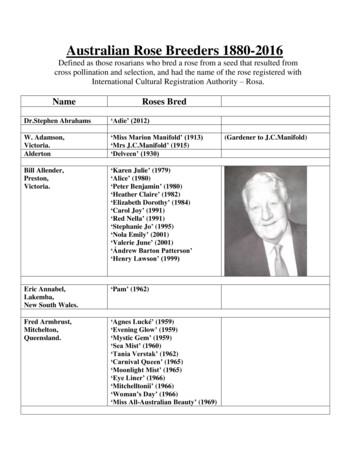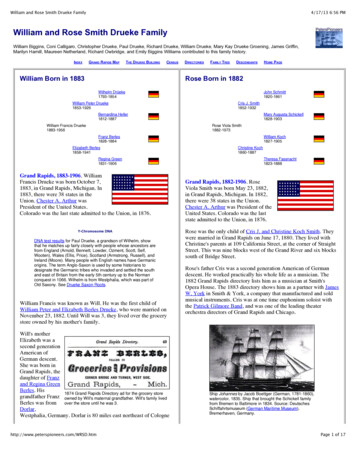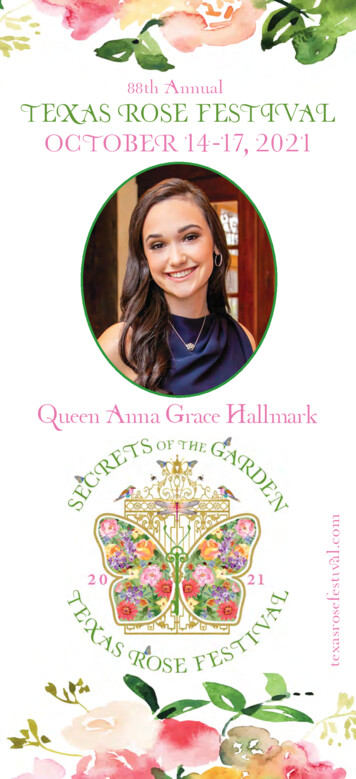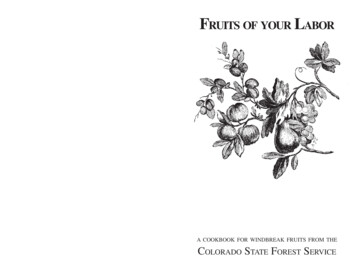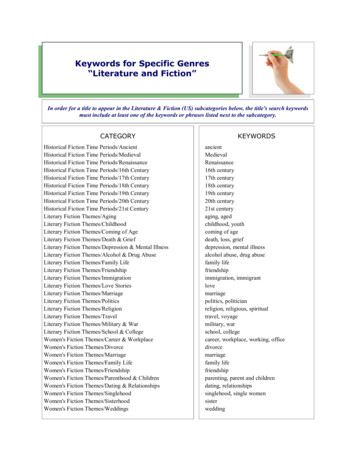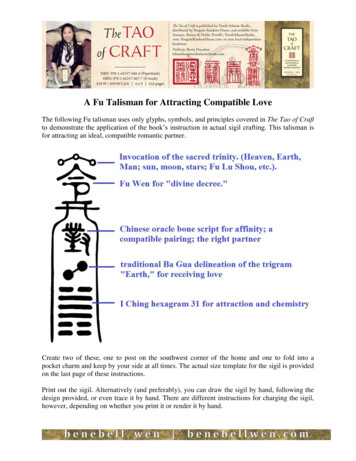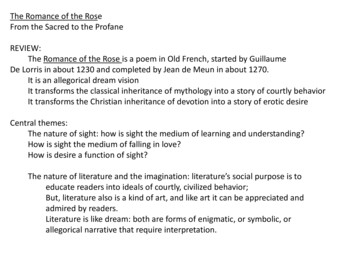
Transcription
The Romance of the RoseFrom the Sacred to the ProfaneREVIEW:The Romance of the Rose is a poem in Old French, started by GuillaumeDe Lorris in about 1230 and completed by Jean de Meun in about 1270.It is an allegorical dream visionIt transforms the classical inheritance of mythology into a story of courtly behaviorIt transforms the Christian inheritance of devotion into a story of erotic desireCentral themes:The nature of sight: how is sight the medium of learning and understanding?How is sight the medium of falling in love?How is desire a function of sight?The nature of literature and the imagination: literature’s social purpose is toeducate readers into ideals of courtly, civilized behavior;But, literature also is a kind of art, and like art it can be appreciated andadmired by readers.Literature is like dream: both are forms of enigmatic, or symbolic, orallegorical narrative that require interpretation.
KEY ISSUES IN THE FIRST SECTION OF THE ROMANCE OF THE ROSE:THE ARGUMENT FOR DREAMS AS MEANINGFULTHE IMAGE OF THE GARDEN AS AN EROTIC TRANSFORMATION OF EDENTHE USE OF THE BLAZON AS THE RHETORICAL DEVICE OF DESCRIBINGTHE WOMANTHE STORY OF NARCISSUS AS A TALE OF SIGHT GONE WRONG, OFDESIRE MISPLACED, AND OF THE FUNDAMENTAL QUESTION OFALL LOVE – IS LOVE, IN THE END, REALLY JUST NARCISSITIC?DO WE SEE OURSELVES IN OUR BELOVEDS, OR SEE THE BELOVED?THE NEW, SOCIAL IDEA THAT LOVE IS A TECHNIQUE: THAT IT CANBE TAUGHT; THAT LOVE IS A METHOD WITH A CLEAR SET OFGOALS; AND THAT SOCIAL BEHAVIOR IN THE COURT AND OUTSIDETHE COURT (COURTESY AND CHIVALRY) CAN BE LEARNED.PART OF THE ROMANCE OF THE ROSE IS THUS A MANUAL OF BEHAVIORFOR A NEW COURTLY WORLD
The transformations of the journeyThe epic, heroic journey of the founding of a city (Aeneid)The religious, salvational journey of the founding of Christianity (New Testament)The spiritual journey of the scholar who becomes a true believer (Confessions)The intellectual journey of the public man who becomes a spiritual being (Consolation)The Romance of the Rose:Love is a journey: it is a struggle towards attainment of desireLove is a CRUSADE: it fights against potential figures of invasion or control in order torecapture something holyLove is also, now, a PILGRIMAGEPILGRIMAGE: THE MEDIEVAL PRACTICE OF TRAVELING TO HOLY SITES, OFTENTO VISIT RELICS OF SAINTS, IN ORDER TO ACHIEVE HEALING OR BLESSING.THE PILGRIMAGE IS THE PERSONAL VERSION OF THE CRUSADE: THAT IS,IT IS SOMETHING THAT ANYONE CAN (AND AT SOME POINT) SHOULD DOIN MEDIEVAL EUROPE. IT IS NOT A BATTLE; IT IS A QUEST.THE GOAL OF THE QUEST IS LIFE – NOT LITERAL IMMORTALITY, BUT A SENSEOF THE TRUE MEANING AND VALIDATION OF LIFE THROUGH THE ENCOUNTERWITH HOLY OR SACRED OBJECTS OR PLACES
THE ROMANCE OF THE ROSE TAKES THESE MEDIEVAL TRADITIONS ANDPRACTICES AND TURNS THEM INTO EROTIC NARRATIVESTHE QUEST IS NOW THE ATTAINMENT OF THE BELOVED, IN PARTICULAR,THE BODY OF THE BELOVED.THE BODY OF THE BELOVED BECOMES A KIND OF HOLY OBJECTTHE BODY PARTS OF THE BELOVED ARE LIKE RELICSTHE BLAZON BECOMES THE TECHNIQUE OF BREAKING UP THE BODYINTO BEAUTIFUL PARTS – OBJECTS NOT OF WORSHIP BUT OFDESIRE.THE MALE LOVER BECOMES A KIND OF PILGRIM OR CRUSADING KNIGHTBECAUSE THE GOAL IS NOW THE PHYSICAL FULFILLMENT OF EROTIC DESIRE,THE STORY MUST BE TOLD ALLEGORICALLY RATHER THAN LITERALLY.
ORIENTALISM: Orientalism is the term used by cultural critics to describe the Westernpractices of imagining Asian or Middle Eastern societies, often through caricatureor exaggeration, in order to privilege Western values: BUT also, at the same time,to make the Asian or Middle Eastern world a place of sensuous, erotic, or temptingdesire. Orientalism in the Romance of the Rose: many passages in this work use imagesof Asian or Middle Eastern places, people, and societies to distinguish Christian andNon-Christian values.p.10: “no woman from here to Jerusalem had a finer neck”p.11: “trees brought here from Alexander’s lands” [some manuscripts have “Saracen”]p.15: God of Love has two “Turkish bows”p.19: Largesse wears a purple robe “from the Orient”p.21: The list of spices at the endp.36: The God of Love says to the dreamer, remarking on how desire for his belovedwill inflame him: “I assure you that the sight will cause your heart to burn and sizzleand that the raging fire will be fanned continually as you gaze. The more a mangazes on what he loves, the more he sets fire to his heart and bastes it with bacon fat.”p.323: The story of Pygmalion, dressing up his statue: “Sometimes he would attireher in a wimple, with a kerchief to cover the wimple and the head, but not the face,for he had no wish to imitate the habit of the Saracens, who are so full of jealous furythat they cover the faces of their women with cloths whenever they go into the streets,so that no passer-by will see them.”
The broader question of love as a CrusadeThe conquest of the rose becomes an allegorically displaced story of the crusadermission: to retake the “holy” sites from the Islamic worldBehind the eroticism of the poem lies a profoundly political and social argument
The Conquest of the Rose:This is the final portion of the poem, written by Jean de Meun. The lover is aboutto mount an attack on the castle that is keeping the Rose. BUT, before we get there,he tells the story of Pygmalion (pp.321-327). WHY does he delay our reading bytelling this story? WELL, remember Virgil in Book IV of the Aeneid deferring theconsummation of Dido and Aeneas. Remember Augustine in Book VIII of the Confessionsdeferring his ultimate conversion in the garden by telling stories of reading.So, the lover/narrator defers, delays, and dilates the narrative to get us even moreImpatient.The story of Pygmalion: the classical sculptor who fell in love with his sculpture; hedresses her up; he goes to bed with her; he is obsessed with her. Finally he prays toVenus and she grants life to the sculpture.Pygmalion and Narcissus: both individuals who fall in love with an imageBUT, Pygmalion’s image is made by him; Pygmalion is a kind of false God, or falseCreator: God makes man in his own image; Pygmalion makes his statue (Galatea) inthe image of desire he wishes.The theme: art has the ability to move and arouse us; what does it mean to be movedBy a work of the imagination? How does literature make something come to life?How does literature revive the dead? How does literature make blood flow into . . . . . . .
The actual attaining of the Rose:The language of crusade and pilgrimage; the language of military conquest“Love conquers all” – how is this a comic, parodic, or just simply crazy misinterpretationof a classical ideal? (pp.328-29)?FOOD FOOD FOOD: Now, the spiritual nourishment is transformed back into physicalsensation:p.332: “Whenever he can get into the kitchen, the epicurean connoisseur of deliciousmorsels tries meats of various kinds, whether boiled in a pot or roasted, marinatedor in a pastry crust, fried or in a galatine.RELIGION RELIGION RELIGION: Now, the idea of the holy relic is transformed intothe physical part of the woman’s bodyp.332: “I longed to touch the relics with my harness . . . . . . “This entire passage is an allegory of . . . .p.334: “While I was in this cramped position . . . I grasped the branches of the rosetree . . . I scattered a little seed there . . . The rose-bud swelled and expanded . . . .”
And so I won my bright red rose.Then it was day and I awoke.Seth with Rosario Dawson,UCSD, May 2016
For next weekDante Vita NuovaHandout has been posted on the course websiteRead through section XIX for Tuesday
The Romance of the Rose From the Sacred to the Profane. REVIEW: The Romance of the Rose is a poem in Old French, started by Guillaume De Lorris in about 1230 and completed by Jean de Meun in about 1270. It is an allegorical dream vision. It transforms the classical
